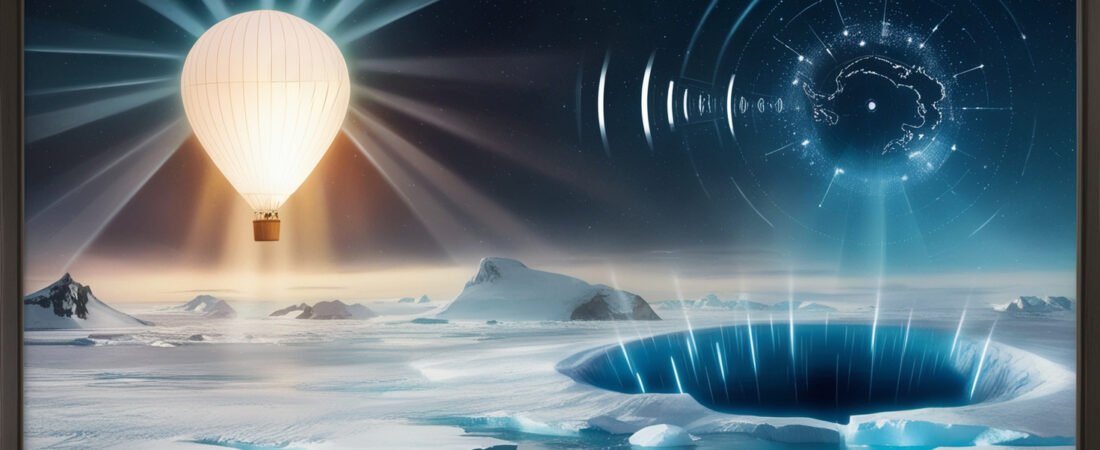Listen on Spotify
Listen on Apple Podcasts
Unveiling the Antarctic Enigma: Did We Detect Signals from a Parallel Universe?
In the icy expanse of Antarctica, a groundbreaking experiment has captured the imagination of scientists and enthusiasts alike. The Antarctic Impulsive Transient Antenna (ANITA), a NASA-funded project, detected mysterious signals that defy conventional physics, sparking debates about the existence of exotic particles, dark matter, or even a parallel universe. Could these findings rewrite the rules of reality, or are they simply misunderstood cosmic phenomena?
The ANITA Experiment
ANITA was designed to study high-energy particles, particularly neutrinos, by detecting radio waves produced when these particles interact with the Earth’s atmosphere. Suspended from a giant balloon floating over Antarctica, the antenna’s unique vantage point allows it to capture signals that ground-based detectors cannot.
In 2006 and 2014, ANITA recorded anomalous signals that appeared to originate from deep within the Earth—an unexpected phenomenon, as neutrinos typically pass through matter without interaction. These signals challenged established models of particle behavior, opening the door to speculative theories and extensive investigation.
Decoding the Mystery of Neutrinos
Neutrinos, often called “ghost particles,” rarely interact with matter, making them elusive and difficult to study. ANITA’s findings suggested that these particles were not only interacting with Antarctic ice but doing so in ways that emitted detectable radio pulses. Scientists turned to the IceCube Neutrino Observatory, the world’s largest neutrino telescope, for corroboration. Surprisingly, IceCube found no matching data, deepening the mystery.
Possible Explanations
The anomalies detected by ANITA sparked a range of theories:
- Natural Phenomena: Some researchers proposed that the signals could result from radio waves bouncing off buried ice caverns or subsurface lakes, creating an illusion of particles originating from within the Earth.
- Exotic Particles: Others speculated the involvement of unknown particles, such as dark matter, which remains one of the universe’s most elusive substances.
- Parallel Universe Hypothesis: Perhaps the most provocative theory suggests the existence of a parallel universe. This speculative idea posits a mirror universe running backward in time, which could explain ANITA’s unusual findings under certain models.
Scientific Caution and Skepticism
While the parallel universe theory captured public attention, it is the most contentious and least substantiated explanation. Physicist Ian Shoemaker proposed a more mundane scenario: ultra-high-energy cosmic rays reflecting off specific ice formations could account for the observed signals without invoking exotic physics.
Stephanie Wissel, a physicist from Penn State, emphasized the need for continued exploration, stating, “We think there is interesting new physics to be done,” while cautioning against premature conclusions.
Future Research with PUEO
To address lingering questions, scientists are developing an upgraded experiment, PUEO (Payload for Ultrahigh Energy Observations), which will feature a larger antenna array to capture more comprehensive data. By refining detection capabilities, researchers hope to distinguish between conventional explanations and groundbreaking discoveries.
Implications of the Findings
If confirmed, these signals could have profound implications for physics and cosmology. The discovery of exotic particles might unlock new understandings of dark matter, while evidence of a parallel universe would challenge the very foundations of reality. However, until more data is collected, the anomalies remain an open question, inviting both curiosity and caution.
Questions Answered
A NASA-funded experiment that detects radio waves from high-energy particle interactions over Antarctica.
They seem to originate from within the Earth, defying typical neutrino behavior.
Hypotheses include radio waves bouncing off ice, exotic particles, or even a parallel universe.
IceCube’s data showed no matching events, suggesting either a flaw in ANITA’s interpretation or the need for alternative explanations.
The PUEO experiment aims to provide clearer insights by enhancing detection capabilities.
Conclusion
The ANITA experiment has sparked one of the most fascinating debates in modern science, blending speculative theories with rigorous inquiry. While the idea of a parallel universe captivates the imagination, it remains unproven, with more conventional explanations currently holding sway. As scientists prepare for the next phase of research with PUEO, the mystery of these Antarctic signals serves as a reminder of the vast unknowns waiting to be explored.

